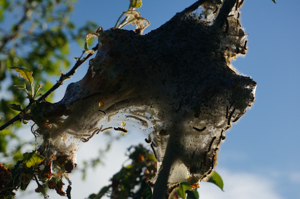 I have squished them with my bare hands, blasted the nests open with a power hose, sprayed them with vinegar, burned them alive with a blow torch, and for those that survived all that, drowned them in soapy water. If you, too, have stood aghast at the havoc they have wreaked in your beloved fruit trees, have vowed to take action, if not declare outright war, and have been somewhat taken aback by their tenacity – yes, we are talking about tent caterpillars – read on. But fair warning: this post is not for the faint of heart!
I have squished them with my bare hands, blasted the nests open with a power hose, sprayed them with vinegar, burned them alive with a blow torch, and for those that survived all that, drowned them in soapy water. If you, too, have stood aghast at the havoc they have wreaked in your beloved fruit trees, have vowed to take action, if not declare outright war, and have been somewhat taken aback by their tenacity – yes, we are talking about tent caterpillars – read on. But fair warning: this post is not for the faint of heart!
Tent caterpillars – Malacosoma spp. – whether you have the Eastern, Western, forest, or webworm variety – or any of the 26 or so species out there – you know them by the tents of silky webbing they spin in the crotches or on the tips of branches. The creatures are colorful, fuzzy, and relatively harmless looking until you see them in large wriggling masses and wake up to find a tree that was once bursting with spring growth, now buck naked.
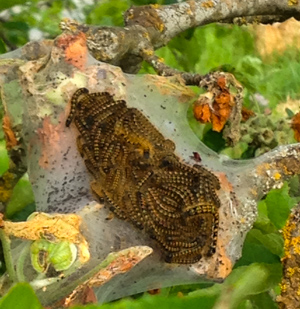 Wikipedia says, “They are often considered pests due to their habit of defoliating trees.” Yep. That’s a pretty nasty habit, alright.
Wikipedia says, “They are often considered pests due to their habit of defoliating trees.” Yep. That’s a pretty nasty habit, alright.
Perhaps we need a little sensitivity training. After all, they are among the most social of all caterpillars and, according to Wikipedia, “exhibit many noteworthy behaviors.” (“Noteworthy” meaning something one might write about; not necessarily likeable.)
To set the record straight, I am not usually creeped out by bugs – but tent caterpillars really, and I do mean really, bug me. I cannot be in the trees with them without feeling like I am covered in creepy crawlies.I, obviously, need this sensitivity training.
A short version of their life cycle:
As soon as the leaves open in spring, the eggs hatch into larvae and start making the family tents. The larvae can go through 6 different stages of growth, depending on the species, during which time the tents get larger and larger. By the time they are mature (4-6 weeks), they are about 1-1.5 inches long and have such a voracious appetite, they can completely defoliate a tree. Come June or July, they find a place to hide, cover themselves in a cocoon, and in about 10 days, magically emerge as a moth. The female secretes a pheromone to attract a male; they mate within the first 24 hours; the female immediately lays her eggs, enclosing them in a protective material; and then they die. Done. One generation is all they get. Life is over that quickly. The eggs somehow survive even -40 F winters, emerge in the spring, and start over.
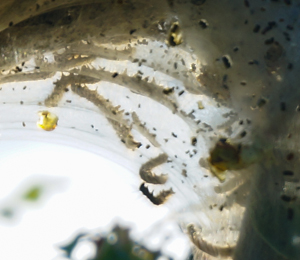 Noteworthy, perhaps:
Noteworthy, perhaps:
- They sleep at night and are awake during the day, just like most of us.
- I noticed that the vast majority of their tents are on the eastern side of the trees, which is where they would receive the morning sun. Studies have in fact shown that the position of the tent is critical, because they have to warm up before they can move about, feed, and digest their food.
- Their tents comprise several layers of silk, separated by gaps that form compartments, which help to insulate the nest. The caterpillars can adjust their body temperature simply by moving from one compartment to another. They, like bees, cluster together to keep each other warm. They can thereby raise the temp a full 50 F degrees warmer than the outside.
- I noticed that many of the tents are on branches that we didn’t get around to pruning – the tender young suckers. They completely surround the leaves, which gives them an indoor food supply. Plus, it is somewhat interesting that their life cycle is timed to coincide with that first flush of growth in spring. Again, studies show that the caterpillars need to complete their development on young leaves that are easier to digest. When the leaves get old, they get tough, like most of us.
- Caterpillars go on food quests, during which they lay down a pheromone trail so they can find their way back home. These trails of webbing are also a way of telling their friends of a good food find. Ants and termites use similar means of communicating to their colony on where to find food.
- After feeding, the caterpillars gather together, sit in the sun, and digest. Um, yeah…
- Because much of the fibrous leaf is indigestible, the caterpillars – in the most delicate way I can describe – excrete a lot of fecal pellets. Consider thousands and thousands of forest caterpillars all excreting fecal pellets from high in the treetops at such a rate that it sounds like rain. Kind of makes you not want to look up, doesn’t it.
- Some types of caterpillars are more nomadic. Others are more central, community-space oriented. Some are loners; others more gregarious.
- Tent caterpillars live in boom and bust cycles, but these cycles are not necessarily at regular intervals. Life is good – or not. Such is life. Some say outbreaks can last 2 or 3 years or more, but a lot of variables can affect that: parasites, diseases, food availability, and other factors. Yes, they can defoliate thousands of acres of forests; however, trees usually recover unless they are already weakened by other factors, such as repeated defoliation, disease, or drought.
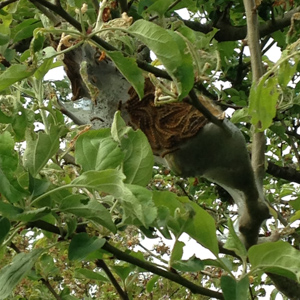 So – What Are Our Options?
So – What Are Our Options?
Most options fall under mechanical, biological, or chemical measures. Here are some ideas to get you started.
Physical / Mechanical Control
Handpick the eggs in winter. While you are pruning, you can put a dent in the population.
Sneak up on them in the early morning. When they are waiting to warm up, this is your best chance to deploy your arsenal of tactics. Evening is also good, but around here, the wind usually picks up by then. Morning is better.
Squish them with your bare hands. Always effective, if not a bit messy.
Set them on fire. I think the hazards here are quite obvious.
Drown them. Prune the branch and submerge it in water, preferably soapy water. This works. However, you may find yourself pruning at points you wouldn’t normally cut.
Run them over with your car. I talked with someone last year who said they were so thick in his area, they were covering the roads – enough to actually make the road slick! That, to me, is just plain sick. Slick sick. Yuk.
Use tools. One website I read suggested that when the caterpillars disperse and enter buildings or cover sidewalks, they can be vacuumed, which I thought a rather novel approach – perhaps something for a Shop-Vac commercial.
Biological Control
The case of Bt. There is a lot of info out there about how well Bt works against caterpillars. Bacillus thuringiensis is a bacterium that produces a protein that is toxic to certain insects. It will not cause food poisoning in humans. In fact, people who ate 1000 mg of Bt/day for 3-5 days showed no ill effects, which makes me wonder what kind of people would be willing to undergo such an experiment – but there you go – so it must be safe, right?
But people, being the thinking idiots they are, consume all kinds of chemicals and poisons with no “reported” effects other than a nagging hangover. But what about the bees? Will Bt harm them (or others that are not making an unconscious choice)?
After all, you are spraying a bacterium on the leaves that will cause death in insects (to make it work, spray it on the leaves, not the caterpillars; the caterpillars eat the leaves, get sick, and then they die; it doesn’t happen immediately, but rather, over a few days; I kind of liken it to eating seriously poisonous mushrooms – you wish you could die, and then you do).
There is a lot of debate about the use of Bt (because it is organic, natural, and all that). It is commonly used in water against mosquito larvae, and in the case of bees, it is sprayed in the hive against wax moths. So if you spray the comb to kill the wax moth, will you also kill the bees? If you spray the tree to kill the caterpillars, will you also put a toxic coating on the remaining flowers that will also hurt your bee friends – or other beneficial insects?
And is Bacillus thuringiensis something you want falling on your face? (I am short; I spray upward; it inevitably falls downward, and even if I try to avoid it, I sometimes miscalculate.)
Some say bees are probably exposed to Bt on a daily basis – after all, it is found in the soil.
It is often sprayed on corn; bees gather the corn pollen and bring it back to the hive, where it is concentrated and fed to larvae with (again, according to recent research) no adverse effects (sorry, the link to the study is no longer valid).
Seriously? How did scientists reach this conclusion? Based on survival vs. mortality? “According to research,” Bt has not been shown to be carcinogenic, nor does it seem to cause birth defects, but it IS an eye irritant in rabbits. Hmmm. Does that mean they sprayed it into rabbits’ eyes to see if it might bother them??
It is important to note that researchers are not measuring sublethal effects; I question whether they really know how. For example, how do you control exposures to a bee and measure behavioral endpoints such as changes in communication and foraging abilities, which are critical to the honeybee’s survival? And if it hurts a bunny’s eyes, what would it do to the elaborate optical system of a bee, with its thousands of light-sensitive cells that help the bee to understand light, color, and direction? How might it interfere with the ability of the antennae to detect different fragrances?
Personally, I don’t think I want Bacillus thuringiensis sprayed on our bee friends or fed to their bee babies. No thank you. And it seems a little bit “out there” to be spraying bacteria around to alter an ecosystem, anyway, does it not?
Enhance Natural Defenses
Improve the health of your trees. A healthy tree can re-grow its leaves. One of the best ways to improve the health of the tree, is to build the soil – and the easiest way I know to do that is to mulch like crazy. I don’t worry too much about individual nutrients; I just try to throw on a variety of things that work together to increase fertility. I am currently scything the orchard and piling the tall grass, dandelions, and other greenery around the drip lines of the trees. I occasionally add composted manure and a wood mulch. Sometimes I spray the trees and ground with kelp and seaweed mixtures. It all helps to build populations of fungi, worms, and various microorganisms that make the nutrients available.
Encourage predators to take up residence. Wasps, spiders, tachnid flies, beetles, ants, frogs, bats, voles and other small mammals, even bears! – as well as a wide variety of birds – jays, nuthatches, orioles, robins, chickadees, downy woodpeckers, blackbirds, and many more – all relish the easy pickin’s of fresh caterpillars and their eggs. Or so they say. I have also read that birds find the tent caterpillars to be rather bitter, so they are not their preferred food source. (Bitter? How do they know that? Are they sure it’s not texture? Fuzzy on the outside, gooey in the center….ewwww). Regardless, growing a variety of plants to encourage beneficial insects to take up residence is a good idea: wildflowers, black-eyed Susan, catnip, Queen Anne’s lace, sweet cicely, angelica, dill, yarrow (any of the umbrella-flowered plants), nasturtiums, and many more are all good. Diversity is key.
“Do not bother killing those with a white egg on their backs” is the advice I find, because a parasite is already killing them for you – unless you want to put them out of their misery. The parasitic wasp pumps her eggs into the caterpillar’s body; the larvae hatch and basically eat the caterpillar from the inside out. As the caterpillar eats, it feeds the larvae until they get so large, they eat their way right out. During that time, they release chemicals that paralyze their host; furthermore, they are protected by a virus that disables the caterpillar’s immune system from killing them while they grow. The caterpillar actually protects the wasp larvae from other predators until it eventually starves to death. All I can say is, nature is more twisted than any horror flick.
Chemical Control:
Assorted homemade sprays. Spray them with soap, vinegar, cayenne, or other substances, with maybe a little oil to make it stick. I have used neem oil on our trees per the advice of Michael Phillips; however, the timing is important, because you can easily kill beneficial insects in the process. According to Mr. Phillips, the right time is before the tree flowers or in the fall. So now is not the time.
Commercial chemicals: Not an option, in my opinion. No discussion.
And you can also…
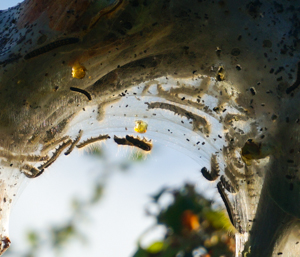 Do Nothing.
Do Nothing.
Which is also something. Yes, you and tent caterpillars CAN live within the same yardspace. They are, after all, a native species and part of the scheme of things. It kind of depends on your tolerance level. They might completely defoliate your tree – then again, they might not. They might get eaten in the process of eating. That’s the way nature works.
It takes a certain amount of restraint to do nothing. After all, whether it be caterpillars or aphids or some other critter, they can suddenly appear in astounding numbers. You can find yourself out there yelling, “Calling all predators! Over here! Over here!”
Unfortunately, predators often multiply more slowly and in fewer numbers than the prey – perhaps it is Nature’s way of ensuring a food supply – so if you kill off the beneficials in the spirit of “saving” the plant, you may very likely be making things worse. The beneficials can be proportionately harder hit, and the prey are likely to survive and multiply in even greater numbers with the predator now eliminated. Which means you will be compelled even more to step in and take control. It’s a slippery slope. Remind yourself: control is an illusion.
Conclusions / Now What?
Back to our sensitivity training session: The question here is – when we have more information, can we not better understand where another is coming from – and through that understanding, learn tolerance, curb our initial animosity, and prevent unnecessary harm? Surely, if we better appreciate the challenges under which one survives and the greater purpose to which their life serves, we can better accept a minor loss to ourselves in the light that it means survival for not one, but many more along the food chain. After all, we are all a part of the web in this safety net we call life. There is room for us all if we give room for one another.
So – In light of that Kum-ba-ya conclusion, what did I do? In the end, there seemed to me to be an imbalance of caterpillars. There were far too many nests proportionate to insects, voles, birds, or marauding opportunists that might consume them. Caterpillars were threatening the life of our trees and most assuredly would obliterate any chance of fruit harvests. I needed to protect the trees. The caterpillars were everywhere. The more I looked, the more I saw them. Their webs completely covered primary branches, and mounds of them squirmed in central locations that were impossible to prune. Spraying them with vinegar obviously made them uncomfortable, but did little to deter them. Burning them was traumatic – they shriveled, writhed and squirmed, and fell to the ground in clumps (which did not all die). I thought it would be a quick death, but it was not. It was painful to watch. Burning became a last resort not for the risk of fire but for the torture it involved. The most humane thing was to cut the branch and submerge it in soapy water. Game over. I found myself apologizing.
I did, by no means, kill them all. There are still plenty of caterpillars for birds and insects or others hungry enough to eat them. Learning about them helped me not to worry about getting every last one. I no longer stressed about complete defoliation. I left the ones in the high treetops and any others that might be lurking in the foliage. I did not risk my life on a ladder in a thunderstorm. Such is spring – short-lived, but intense. And such is the life of the caterpillar.
I am undoubtedly either going to caterpillar karma hell – or for my valiant efforts, will dwell in a tree paradise. I am not sure which.
~*~
Epilogue:
You know, it is such a tragedy when a life is all for naught – and I so hate it when things go to waste. I was lamenting this fact as I dumped out the soapy water with all the dead caterpillars. I mean – what purpose do they serve if they aren’t at least food for something else? And it was then that I noticed the deep orange color of the water – quite beautiful, really – and I thought, well, people dye fibers with cochineal, an insect; why not caterpillars? I often play around with plant dyes, but I had not been willing to use animals. Just something wrong about that. However, under the circumstances, I thought I might do a little experiment. So on the second bucket, I threw in an old cotton pillow case to soak. I will keep you posted on the results. It’s pretty gross at the moment, to be honest.
References & Resources:
Websites:
Alternatives: A Washington Toxics Coalition Fact Sheet: Managing Tent Caterpillars Without Chemicals
Bacillus thuringiensis : Animal Safety
Parasitic Wasp Larvae Emerging from Caterpillar – Nature can be horrifying
Wikipedia: Tent Caterpillars
WSU Whatcom County Extenstion: Western Tent Caterpillar Update
Effects of Bt corn pollen on honey bees: emphasis on protocol development (research by U of MD and the USDA). (Note: I am sorry. It appears this link is no longer valid and I am unable to find it. I am not sure whether it is part of a larger conspiracy.)
Organic Gardening: Tent Caterpillars – How to control the devastating tent caterpillar: Sadly, the Organic Gardening.com website through Rodale has been discontinued since this post was written. You can still get a lot of great info over at the Rodale Institute, but I didn’t find anything on tent caterpillars.
Books
Gaia’s Garden, Toby Hemenway – one of my very favorite books
The Holistic Orchard, Michael Phillips
Other Blogposts at Barbolian Fields
To Convert an Orchard to a Food Forest, Start with the Soil
When I was a residential student at a small rural Quaker school (back in the 60’s) there was a huge infestation of our many fruit trees – an essential part of our diet. We waited til evening, tied an oily rag to the end of a very long pole, lit it on fire, and then set each nest on fire. Because it had been a rainy wet Spring we weren’t in danger of setting anything else on fire, including the trees. Yes, it sounds horrible BUT there was something really satisfying about seeing those voracious creatures eliminated. These days I resort to drowning! Thanks for your article!
I know exactly what you mean. Horrible, but somehow satisfying to protect the trees. I could not wait for beneficial insects to do them in or for the caterpillars to run through their life cycle, and birds didn’t seem to like them — the trees would have been denuded had I not taken action. Could they recover? Probably – but they would have been even more susceptible to disease and pests. In the end, I couldn’t handle the squirming under fire; drowning seemed more humane. I try not to kill anything these days if I can help it. The “fire on a pole” technique is worth remembering, though, for those desperate situations that require drastic measures in hard-to-reach areas! Fortunately, we haven’t had a serious outbreak since – and now that I’ve said that, it will probably happen! Thanks so much for taking the time to comment. There is a lot we can learn from the Quakers!
I loved reading your article and laughed out loud several times (which I needed since we’re in the middle of the pandemic right now as I write this, with mostly overwhelming and grim news out there). You are a gifted storyteller!!
But also great overview and advice. Thanks so much. I stumbled across it because I was trying to figure out if I could drown the tent caterpillars having just cut them out of my apple tree. And drown them I did!!!
Your comment made my day, Yolanda. I am not sure how gifted I am, but if my acts of terrorism actually helped someone, I can sleep better at night. As you embark on your own personal murderous rampage, I would concur that drowning is the most humane option. If, however, they have pushed you to the point of taking angry revenge or instilled such fear that you resort to absurd tactics (as I did, justified by my mission to “save the trees”) – may I just say: No Judgment Here! (I’ll leave that to the great horned caterpillar in the sky.) LOL! Best of luck to you! And thank you for signing up to the BF Fan Club!
How did the pillow turn out?
It was high on the Yuk scale. I wouldn’t call it a pastel dye… more of a stain. Not one of my best experiments and not one that I am likely to repeat. Still, it was worth a shot. I file it in the “educational” category. Thanks for asking.